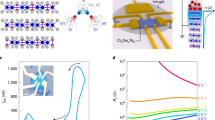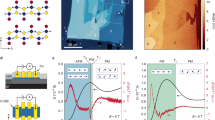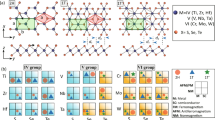Abstract
Manipulating a quantum state via electrostatic gating has been of great importance for many model systems in nanoelectronics. Until now, however, controlling the electron spins or, more specifically, the magnetism of a system by electric-field tuning has proven challenging1,2,3,4. Recently, atomically thin magnetic semiconductors have attracted significant attention due to their emerging new physical phenomena5,6,7,8,9,10,11,12,13. However, many issues are yet to be resolved to convincingly demonstrate gate-controllable magnetism in these two-dimensional materials. Here, we show that, via electrostatic gating, a strong field effect can be observed in devices based on few-layered ferromagnetic semiconducting Cr2Ge2Te6. At different gate doping, micro-area Kerr measurements in the studied devices demonstrate bipolar tunable magnetization loops below the Curie temperature, which is tentatively attributed to the moment rebalance in the spin-polarized band structure. Our findings of electric-field-controlled magnetism in van der Waals magnets show possibilities for potential applications in new-generation magnetic memory storage, sensors and spintronics.
This is a preview of subscription content, access via your institution
Access options
Access Nature and 54 other Nature Portfolio journals
Get Nature+, our best-value online-access subscription
$29.99 / 30 days
cancel any time
Subscribe to this journal
Receive 12 print issues and online access
$259.00 per year
only $21.58 per issue
Buy this article
- Purchase on Springer Link
- Instant access to full article PDF
Prices may be subject to local taxes which are calculated during checkout





Similar content being viewed by others
References
Chappert, C., Fert, A. & Nguyen Van Dau, F. The emergence of spin electronics in data storage. Nat. Mater. 6, 813–823 (2007).
Matsukura, F., Tokura, Y. & Ohno, H. Control of magnetism by electric fields. Nat. Nanotech. 10, 209–220 (2015).
Lin, M.W. et al. Ultrathin nanosheets of CrSiTe3: a semiconducting two-dimensional ferromagnetic material. J. Mater. Chem. C 4, 315–322 (2016).
Xing, W. et al. Electric field effect in multilayer Cr2Ge2Te6: a ferromagnetic 2D material. 2D Mater. 4, 024009 (2017).
Huang, B. et al. Layer-dependent ferromagnetism in a van der Waals crystal down to the monolayer limit. Nature 546, 270–273 (2017).
Gong, C. et al. Discovery of intrinsic ferromagnetism in two-dimensional van der Waals crystals. Nature 546, 265–269 (2017).
Wang, Z. et al. Very large tunneling magnetoresistance in layered magnetic semiconductor CrI3. Preprint at https://arxiv.org/abs/1801.08188 (2018).
Klein, D. R. et al. Probing magnetism in 2D van der Waals crystalline insulators via electron tunneling. Science 360, 1218–1222 (2018).
Song, T. C. et al. Giant tunneling magnetoresistance in spin-filter van der Waals heterostructures. Science 360, 1214–1218 (2018).
Sivadas, N., Daniels, M. W., Swendsen, R. H., Okamoto, S. & Xiao, D. Magnetic ground state of semiconducting transition-metal trichalcogenide monolayers. Phys. Rev. B 91, 235425 (2015).
Mounet, N. et al. Two-dimensional materials from high-throughput computational exfoliation ofexperimentally known compounds. Nat. Nanotech. 13, 246–252 (2018).
Bonilla, M. et al. Strong room-temperature ferromagnetism in VSe2 monolayers on van der Waals substrates. Nat. Nanotech. 13, 289–293 (2018).
Arai, M. et al. Construction of van der Waals magnetic tunnel junction using ferromagnetic layereddichalcogenide. Appl. Phys. Lett. 107, 103107 (2015).
Cherifi, R. O. et al. Electric-field control of magnetic order above room temperature. Nat. Mater. 13, 345–351 (2014).
Chiba, D. et al. Electrical control of the ferromagnetic phase transition in cobalt at room temperature. Nat. Mater. 10, 853–856 (2011).
Weisheit, M. Electric Field-induced modification of magnetism in thin-film ferromagnets. Science 315, 349–351 (2007).
Shimamura, K. et al. Electrical control of Curie temperature in cobalt using an ionic liquid film. Appl. Phys. Lett. 100, 122402 (2012).
Wang, W. G., Li, M., Hageman, S. & Chien, C. L. Electric-field-assisted switching in magnetic tunneljunctions. Nat. Mater. 11, 64–68 (2012).
Maruyama, T. et al. Large voltage-induced magnetic anisotropy change in a few atomic layers of iron. Nat. Nanotech. 4, 158–161 (2009).
Wang, Y. Y. et al. Electrical control of the exchange spring in antiferromagnetic metals. Adv. Mater. 27, 3196–3201 (2015).
Ohno, H. et al. Electric-field control of ferromagnetism. Nature 408, 944–946 (2000).
Chiba, D., Yamanouchi, M., Matsukura, F. & Ohno, H. Electrical manipulation of magnetization reversal in aferromagnetic semiconductor. Science 301, 943–945 (2003).
Zhang, Y. B., Tan, Y. W., Stormer, H. L. & Kim, P. Experimental observation of the quantum Hall effect andBerry’s phase in graphene. Nature 438, 201–204 (2005).
Ye, J. T. et al. Liquid-gated interface superconductivity on an atomically flat film. Nat. Mater. 9, 125–128 (2010).
Yuan, H. T. et al. Electrostatic and electrochemical nature of liquid-gated electric-double-layer transistorsbased on oxide semiconductors. J. Am. Chem. Soc. 132, 18402–18407 (2010).
Guo, T. et al. Multiple structure and symmetry types in narrow temperature and magnetic field ranges intwo-dimensional Cr2Ge2Te6 crystal. Preprint at https://arxiv.org/abs/1803.06113 (2018).
Stöhr, J. & Siegmann, H. C. Magnetism from Fundamentals to Nanoscale Dynamics (Springer, Berlin, 2006).
Jiang, S. W., Li, L. Z., Wang, Z. F., Mak, K. F. & Shan, J. Controlling magnetism in 2D CrI3 by electrostatic doping. Nat. Nanotech. https://doi.org/10.1038/s41565-018-0135-x (2018).
Huang, B. et al. Electrical control of 2D magnetism in bilayer CrI3. Nat. Nanotech. https://doi.org/10.1038/s41565-018-0121-3.
Deng, Y. J. et al. Gate-tunable room-temperature ferromagnetism in two-dimensional Fe3GeTe2. Preprint at https://arxiv.org/abs/1803.02038 (2018).
Kresse, G. & Furthmüller, J. Efficient iterative schemes for ab initio total-energy calculations using a planewavebasis set. Phys. Rev. B. 54, 11169 (1996).
Cococcioni, M. & de Gironcoli, S. Linear response approach to the calculation of the effective interactionparameters in the LDA+U method. Phys. Rev. B. 71, 035105 (2005).
Kresse, G. & Joubert, D. From ultrasoft pseudopotentials to the projector augmented-wave method. Phys. Rev. B 59, 1758 (1999).
Evans, R. F. L. et al. Atomistic spin model simulations of magnetic nanomaterials. J. Phys. Condens. Matter 26, 103202 (2014).
Acknowledgements
This work was supported by the National Key R&D Program of China (2017YFA0206302) and by the National Natural Science Foundation of China (NSFC; grants 11504385 and 51627801). Z.Z. acknowledges support from the NSFC (grant 51331006) and the CAS (project KJZD-EW-M05-3). T.Y. acknowledges support from the Major Program of Aerospace Advanced Manufacturing Technology Research Foundation, NSFC and CASC (grant U1537204). The work in Shanxi University was supported financially by the NSFC (grant 61574087) and the Fund for Shanxi ‘1331 Project’ Key Subjects Construction (1331KSC). D.S. acknowledges support from the NSFC (grants 51272256, 61422406 and 61574143) and MSTC (grant 2016YFB04001100). S.O. acknowledges support from Grants-in-Aid for Scientific Research (S) (25220604) and LANEF. The authors are grateful for discussions with H. Yuan.
Author information
Authors and Affiliations
Contributions
Z.H. and Z.Z. conceived the experiment and supervised the overall project. Z.W., X.L. and Y.Y. fabricated the samples. Z.W., T.Z., Ya.L., Y.C. and Z.H. carried out experimental measurements. S.O. provided the ionic liquid and advised on the experiment. B.D., J.H. and T.Y. conducted the theoretical simulations. Z.H., M.D., T.Z., T.Y. and Y.C. analysed the data. The manuscript was written by Z.H., Y.C. and T.Y. All authors discussed the results and commented on the manuscript.
Corresponding authors
Ethics declarations
Competing interests
The authors declare no competing interests.
Additional information
Publisher’s note: Springer Nature remains neutral with regard to jurisdictional claims in published maps and institutional affiliations.
Supplementary information
Supplementary Information
Supplementary Figures 1–23
Rights and permissions
About this article
Cite this article
Wang, Z., Zhang, T., Ding, M. et al. Electric-field control of magnetism in a few-layered van der Waals ferromagnetic semiconductor. Nature Nanotech 13, 554–559 (2018). https://doi.org/10.1038/s41565-018-0186-z
Received:
Accepted:
Published:
Issue Date:
DOI: https://doi.org/10.1038/s41565-018-0186-z
This article is cited by
-
Ferrielectricity controlled widely-tunable magnetoelectric coupling in van der Waals multiferroics
Nature Communications (2024)
-
Electric control of optically-induced magnetization dynamics in a van der Waals ferromagnetic semiconductor
Nature Communications (2024)
-
Two-dimensional magnetic materials for spintronic applications
Nano Research (2024)
-
Small-voltage multiferroic control of two-dimensional magnetic insulators
Nature Electronics (2023)
-
Interfacial engineering of ferromagnetism in wafer-scale van der Waals Fe4GeTe2 far above room temperature
Nature Communications (2023)



